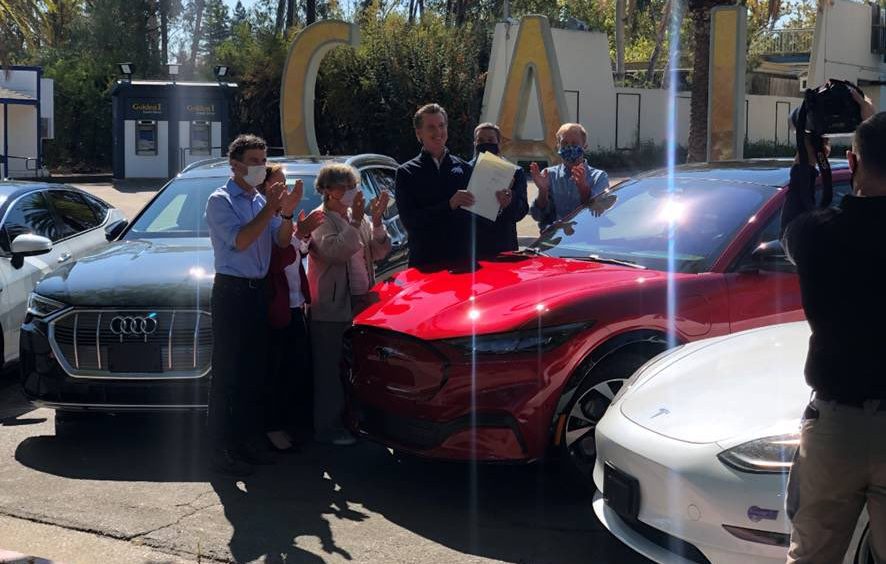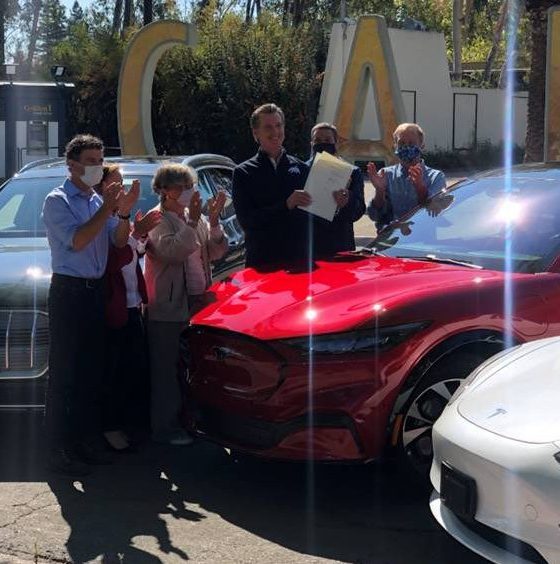

News
Ford seemingly denies Tesla’s existence as it supports CA’s zero-emissions initiative
A recent press conference from California Governor Gavin Newsom proved to be quite interesting for the Tesla and electric car community. During his speech, where he praised California’s place as the leader in the United States’ electric vehicle movement, the governor dubbed veteran automaker Ford as the leader in the EV sector. Even more interestingly, the CA governor seemed almost intent to leave Tesla out when he was speaking about the state’s EV milestones.
The governor’s speech was shared on Twitter by Ford COO Jim Farley, who noted that the veteran carmaker is the only American automaker to stand behind California in its efforts to reduce greenhouse gas emissions. This statement promptly raised some eyebrows and sarcastic jokes from the online EV community, considering that Tesla, an all-American automaker, has been mass-producing zero-emissions cars in the state for years. The fact that there was a Model 3 parked beside a Ford Mustang Mach-E during the speech was just icing on the cake.
“I want to thank in particular a number of automobile manufacturers that get it and are starting to get it done, led by Bill Ford and Ford. They have been a leader in this space. They’re not a laggard, and they’re not willing to just suffer the fate of a future of dirtier air, dirtier water, and more climate disruption. They want to lead and they are leading with innovation and an entrepreneurial mindset that’s leading to more customer choice, that’s leading to new technological advancements, and allow them to be on the vanguard of leadership, not just in the United States as a manufacturer, but around the rest of the world,” the governor said.
As noted by tech YouTuber and EV advocate Jeremy Judkins, things get even more interesting when one looks at the governor’s statements before his comments on Ford’s EV leadership. Newsom highlighted that California has 34 manufactures of electric vehicles, and he also remarked that EVs represent the second-largest export of the state. The governor added that the market caps of the publicly-traded electric car makers in California stand at nearly half a trillion dollars.
“Currently today, the state has 34 manufacturers of electric vehicles. No state in America comes close. This state represents just shy of 50% of all the electric vehicle purchases in the United States of America. We have, by one estimate, close to three-quarters of a million electric vehicles in the State of California — 726,000 at last count— no state comes close. Our second-largest export, rather, in the State of California is electric vehicles.
“Those 34 manufacturers represent — those publicly traded manufacturers — represent close to one half a trillion dollars of market capitalization. Some $500 billion. This is an economic opportunity, the opportunity to transform our economy across sectors, the opportunity to accelerate innovation in the entrepreneurial spirit, the opportunity to bring more companies here into the State of California, creating more jobs,” Newsom said.
It should be noted that Tesla represents the lion’s share of the EV exports that the California governor was referring to. The company also represents the majority of the combined $500 billion market cap of the state’s electric car makers, considering that Tesla currently has a market cap of about $360 billion on its own. These figures, as well as the presence of a literal Tesla just a few feet away from Newsom’s podium, made the governor’s speech rather peculiar on its own.
Granted, Ford could probably justify its statements by claiming that Tesla is not a pure automaker, but a tech company per se. Still, the rather discrete denial of the electric car maker’s existence in an event about reducing greenhouse gas emissions is still quite strange nonetheless. That being said, Ford could not claim to be a purely American carmaker either, considering that some of the vehicles it sells in the country are produced in foreign territories. The Mustang Mach-E, for example, will be made in Ford’s Cuautitlán Izcalli, Mexico plant, making the vehicle not quite as “American” as its competitor, the Tesla Model Y, which is produced in California.

Elon Musk
Elon Musk and Tesla AI Director share insights after empty driver seat Robotaxi rides
The executives’ unoccupied tests hint at the rapid progress of Tesla’s unsupervised Robotaxi efforts.

Tesla CEO Elon Musk and AI Director Ashok Elluswamy celebrated Christmas Eve by sharing personal experiences with Robotaxi vehicles that had no safety monitor or occupant in the driver’s seat. Musk described the system’s “perfect driving” around Austin, while Elluswamy posted video from the back seat, calling it “an amazing experience.”
The executives’ unoccupied tests hint at the rapid progress of Tesla’s unsupervised Robotaxi efforts.
Elon and Ashok’s firsthand Robotaxi insights
Prior to Musk and the Tesla AI Director’s posts, sightings of unmanned Teslas navigating public roads were widely shared on social media. One such vehicle was spotted in Austin, Texas, which Elon Musk acknowleged by stating that “Testing is underway with no occupants in the car.”
Based on his Christmas Eve post, Musk seemed to have tested an unmanned Tesla himself. “A Tesla with no safety monitor in the car and me sitting in the passenger seat took me all around Austin on Sunday with perfect driving,” Musk wrote in his post.
Elluswamy responded with a 2-minute video showing himself in the rear of an unmanned Tesla. The video featured the vehicle’s empty front seats, as well as its smooth handling through real-world traffic. He captioned his video with the words, “It’s an amazing experience!”
Towards Unsupervised operations
During an xAI Hackathon earlier this month, Elon Musk mentioned that Tesla owed be removing Safety Monitors from its Robotaxis in Austin in just three weeks. “Unsupervised is pretty much solved at this point. So there will be Tesla Robotaxis operating in Austin with no one in them. Not even anyone in the passenger seat in about three weeks,” he said. Musk echoed similar estimates at the 2025 Annual Shareholder Meeting and the Q3 2025 earnings call.
Considering the insights that were posted Musk and Elluswamy, it does appear that Tesla is working hard towards operating its Robotaxis with no safety monitors. This is quite impressive considering that the service was launched just earlier this year.
Elon Musk
Starlink passes 9 million active customers just weeks after hitting 8 million
The milestone highlights the accelerating growth of Starlink, which has now been adding over 20,000 new users per day.

SpaceX’s Starlink satellite internet service has continued its rapid global expansion, surpassing 9 million active customers just weeks after crossing the 8 million mark.
The milestone highlights the accelerating growth of Starlink, which has now been adding over 20,000 new users per day.
9 million customers
In a post on X, SpaceX stated that Starlink now serves over 9 million active users across 155 countries, territories, and markets. The company reached 8 million customers in early November, meaning it added roughly 1 million subscribers in under seven weeks, or about 21,275 new users on average per day.
“Starlink is connecting more than 9M active customers with high-speed internet across 155 countries, territories, and many other markets,” Starlink wrote in a post on its official X account. SpaceX President Gwynne Shotwell also celebrated the milestone on X. “A huge thank you to all of our customers and congrats to the Starlink team for such an incredible product,” she wrote.
That growth rate reflects both rising demand for broadband in underserved regions and Starlink’s expanding satellite constellation, which now includes more than 9,000 low-Earth-orbit satellites designed to deliver high-speed, low-latency internet worldwide.
Starlink’s momentum
Starlink’s momentum has been building up. SpaceX reported 4.6 million Starlink customers in December 2024, followed by 7 million by August 2025, and 8 million customers in November. Independent data also suggests Starlink usage is rising sharply, with Cloudflare reporting that global web traffic from Starlink users more than doubled in 2025, as noted in an Insider report.
Starlink’s momentum is increasingly tied to SpaceX’s broader financial outlook. Elon Musk has said the satellite network is “by far” the company’s largest revenue driver, and reports suggest SpaceX may be positioning itself for an initial public offering as soon as next year, with valuations estimated as high as $1.5 trillion. Musk has also suggested in the past that Starlink could have its own IPO in the future.
News
NVIDIA Director of Robotics: Tesla FSD v14 is the first AI to pass the “Physical Turing Test”
After testing FSD v14, Fan stated that his experience with FSD felt magical at first, but it soon started to feel like a routine.

NVIDIA Director of Robotics Jim Fan has praised Tesla’s Full Self-Driving (Supervised) v14 as the first AI to pass what he described as a “Physical Turing Test.”
After testing FSD v14, Fan stated that his experience with FSD felt magical at first, but it soon started to feel like a routine. And just like smartphones today, removing it now would “actively hurt.”
Jim Fan’s hands-on FSD v14 impressions
Fan, a leading researcher in embodied AI who is currently solving Physical AI at NVIDIA and spearheading the company’s Project GR00T initiative, noted that he actually was late to the Tesla game. He was, however, one of the first to try out FSD v14.
“I was very late to own a Tesla but among the earliest to try out FSD v14. It’s perhaps the first time I experience an AI that passes the Physical Turing Test: after a long day at work, you press a button, lay back, and couldn’t tell if a neural net or a human drove you home,” Fan wrote in a post on X.
Fan added: “Despite knowing exactly how robot learning works, I still find it magical watching the steering wheel turn by itself. First it feels surreal, next it becomes routine. Then, like the smartphone, taking it away actively hurts. This is how humanity gets rewired and glued to god-like technologies.”
The Physical Turing Test
The original Turing Test was conceived by Alan Turing in 1950, and it was aimed at determining if a machine could exhibit behavior that is equivalent to or indistinguishable from a human. By focusing on text-based conversations, the original Turing Test set a high bar for natural language processing and machine learning.
This test has been passed by today’s large language models. However, the capability to converse in a humanlike manner is a completely different challenge from performing real-world problem-solving or physical interactions. Thus, Fan introduced the Physical Turing Test, which challenges AI systems to demonstrate intelligence through physical actions.
Based on Fan’s comments, Tesla has demonstrated these intelligent physical actions with FSD v14. Elon Musk agreed with the NVIDIA executive, stating in a post on X that with FSD v14, “you can sense the sentience maturing.” Musk also praised Tesla AI, calling it the best “real-world AI” today.








